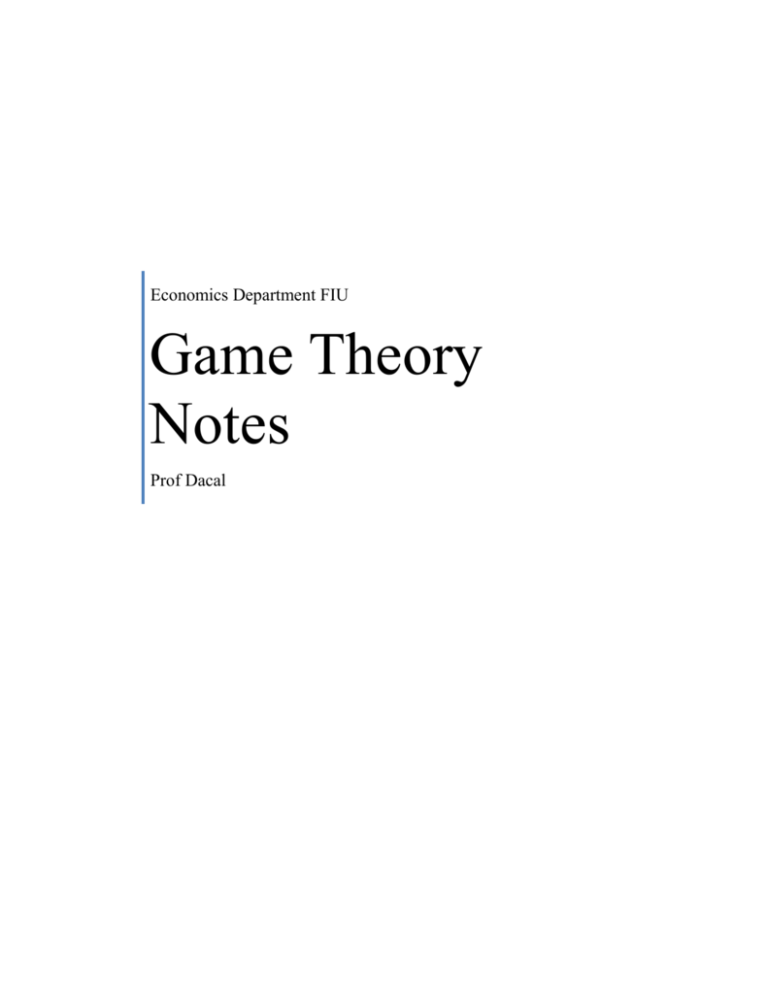Game Theory Notes - FIU Faculty Websites
advertisement

Economics Department FIU Game Theory Notes Prof Dacal Game Theory Notes Game theory From Wikipedia [with modifications] Game theory is a branch of applied mathematics that is used in the social sciences, most notably in economics. Game theory attempts to mathematically capture behavior in strategic situations, or games, in which an individual's success in making choices depends on the choices of others. While initially developed to analyze competitions in which one individual does better at another's expense (zero sum games). Traditional applications of game theory attempt to find equilibrium in these games. In equilibrium, each player of the game has adopted a strategy that they are unlikely to change (most famous the Nash equilibrium). Representation of games A game consists of a set of players, a set of moves (or strategies) available to those players, and a specification of payoffs for each combination of strategies. Most cooperative games are presented in the characteristic function form, while the extensive and the normal forms are used to define non-cooperative games. Extensive form An extensive form game The extensive form can be used to formalize games with some important order. Games here are often presented as trees (as pictured above). Here each node represents a point of choice for a player. The player is specified by a number listed by the node. The lines out of the node represent a possible action for that player. The payoffs are specified at the bottom of the tree. In the game pictured here, there are two players. Player 1 moves first and chooses either F or U. Player 2 sees Player 1's move and then chooses A or R. Suppose that Player 1 chooses U and then Player 2 chooses A, then Player 1 gets 8 and Player 2 gets 2. The extensive form can also capture simultaneous-move games and games with imperfect information or asymmetric information. To represent it, either a dotted line connects different vertices to represent them as being part of the same information set (i.e., the players do not know at which point they are), or a closed line is drawn around them. 2|Page Game Theory Notes Normal form The normal (or strategic form) game is Player 2 Player 2 usually represented by a matrix which shows chooses Left chooses Right the players, strategies, and payoffs (see the example to the right). More generally it can Player 1 4, 3 –1, –1 be represented by any function that associates chooses Up a payoff for each player with every possible combination of actions. In the accompanying Player 1 0, 0 3, 4 example there are two players; one chooses chooses Down the row and the other chooses the column. Each player has two strategies (‘in this Normal form or payoff matrix of a 2-player, 2example, but we could have more in our strategy game class’), which are specified by the number of rows and the number of columns. The payoffs are provided in the interior. The first number is the payoff received by the row player (Player 1 in our example); the second is the payoff for the column player (Player 2 in our example). Suppose that Player 1 plays Up and that Player 2 plays Left. Then Player 1 gets a payoff of 4, and Player 2 gets 3. When a game is presented in normal form, it is presumed that each player acts simultaneously or, at least, without knowing the actions of the other. If players have some information about the choices of other players, the game is usually presented in extensive form. Economics and business Economists have long used game theory to analyze a wide array of economic phenomena, including auctions, bargaining, duopolies, fair division, oligopolies, social network formation, and voting systems and to model across such broad classifications as behavioral economics[2] and industrial organization.[3] This research usually focuses on particular sets of strategies known as equilibria in games. These "solution concepts" are usually based on what is required by norms of rationality. In non-cooperative games, the most famous of these is the Nash equilibrium. If each player’s strategy represents the best response to the other strategies, this set of strategies is a Nash equilibrium. So, if all the players are playing the strategies in a Nash equilibrium, they have no unilateral incentive to deviate, since their strategy is the best they can do given what others are doing. The payoffs of the game are generally taken to represent the utility (‘or disutility if it is negative’) of individual players. Often in modeling situations the payoffs represent money, which presumably corresponds to an individual's utility. This assumption, however, can be faulty. 3|Page Game Theory Notes Types of games Symmetric and asymmetric A symmetric game is a game where the payoffs for playing a particular strategy depend only on the other strategies employed, not on who is playing them. If the identities of the players can be changed without changing the payoff to the strategies, then a game is symmetric. Many of the commonly studied 2×2 games are symmetric. The standard representations of chicken, the prisoner's dilemma, and the stag hunt are all symmetric games. E F E 1, 2 0, 0 F 0, 0 1, 2 An asymmetric game Most commonly studied asymmetric games are games where there are not identical strategy sets for both players. For instance, the ultimatum game and similarly the dictator game have different strategies for each player. It is possible, however, for a game to have identical strategies for both players, yet be asymmetric. For example, the game pictured to the right is asymmetric despite having identical strategy sets for both players. Zero-sum Zero-sum games are a special case of constant-sum games, in A B which choices by players can neither increase nor decrease the available resources. In zero-sum games the total benefit to all A –1, 1 3, –3 players in the game, for every combination of strategies, always adds to zero (more informally, a player benefits only at B 0, 0 –2, 2 the equal expense of others). Poker exemplifies a zero-sum game (ignoring the possibility of the house's cut), because one A zero-sum game wins exactly the amount one's opponents lose. Other zero-sum games include matching pennies and most classical board games including Go and chess. Simultaneous and sequential Simultaneous games are games where both players move simultaneously, or if they do not move simultaneously, the later players are unaware of the earlier players' actions (making them effectively simultaneous). Sequential game (or dynamic games) are games where later players have some knowledge about earlier actions. This need not be perfect information about every action of earlier players; it might be very little knowledge. For instance, a player may know that an earlier player did not perform one particular action, while he does not know which of the other available actions the first player actually performed. The difference between simultaneous and sequential games is captured in the different representations discussed above. Often, normal form is used to represent simultaneous games, 4|Page Game Theory Notes and extensive form is used to represent sequential ones; although this isn't a strict rule in a technical sense. Perfect information and imperfect information A game of imperfect information (the dotted line represents ignorance on the part of player 2) An important subset of sequential games consists of games of perfect information. A game is one of perfect information if all players know the moves previously made by all other players. Thus, only sequential games can be games of perfect information, since in simultaneous games not every player knows the actions of the others. Most games studied in game theory are imperfect-information games. Perfect-information games include chess. Perfect information is often confused with complete information, which is a similar concept. Complete information requires that every player know the strategies and payoffs of the other players but not necessarily the actions. Infinitely long games Games, as studied by economists and real-world game players, are generally finished in finitely many moves. Pure mathematicians are not so constrained, and set theorists in particular study games that last for infinitely many moves, with the winner (or other payoff) not known until after all those moves are completed. Discrete and continuous games Much of game theory is concerned with finite, discrete games, that have a finite number of players, moves, events, outcomes, etc. Many concepts can be extended, however. Continuous games allow players to choose a strategy from a continuous strategy set. For instance, Cournot competition is typically modeled with players' strategies being any non-negative quantities, including fractional quantities (this is a game for duopolies). 5|Page






